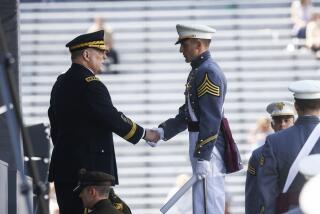DEFENSE STRATEGY DRAWING A BLUEPRINT : A Lonely March Into a New Era : Just as it did after Vietnam, today’s Army must go it alone in restructuring while still trying to be all that it can be.
- Share via
Building “great logical edifices on foundations of gas.” That’s the difficult engineering task facing Army Chief of Staff Gen. Carl Vuono as he sets out to construct an Army to protect, defend and enhance the worldwide interests of the United States in the post-Cold War era. In many ways it’s a repeat of the challenge faced by then-Army Chief of Staff Gen. Creighton Abrams 17 years ago when the Vietnam War was drawing to a close.
In theory, the job should not be all that difficult. Supposedly derived from the national purpose and the national policy that set the goals and objectives of the United States, the blueprint for the Army is simply the military portion of the national strategy--that is, how the nation plans to use its political, economic, social and psychological power, as well as its military power, to achieve the ends it establishes for itself.
There’s only one thing wrong with this logical approach to strategy formulation. In reality, as Gen. Abrams pointed out in 1973, all those theoretical constructs are just so much gas. Aside from pious platitudes, there is no foundation of national purpose and national policy upon which to build. As a result, there is no national strategy worthy of the name.
For the State Department, this defect may seem a blessing because it provides room for diplomatic maneuver. But for the Defense Department it can be a fatal flaw. For good reason, focus on the objective is the first principle of war, and failure to adhere to this can be disastrous. In Vietnam, for example, Brig. Gen. Douglas Kinnard (later chief of military history) found that “almost 70% of the Army generals who managed the war were uncertain of its objectives.” That statistic alone explains our failure there.
As Kinnard emphasized, it mirrored “a deep-seated strategic failure: the inability of policy-makers to frame tangible, obtainable goals.” And it was a failure that continued into the subsequent peace, where it also had the potential for disaster. To deter aggression, the Army must be properly manned, organized, structured, armed and equipped. To do all this, the military must have at least a conception of the missions it would likely be called upon to perform. This was especially so in the post-Vietnam era of constrained budgets, where all contingencies could no longer be covered and hard choices had to be made.
But, distracted by their wild-goose chase for “peace dividends,” no one in the Administration or Congress wanted to bite that bullet. The Army would have to devise its own blueprint. Working closely with then-Secretary of Defense James Schlesinger and leaders in Congress, Abrams began to construct an Army for the post-Vietnam War era.
Its most remarkable feature was the reintegration of the National Guard and the Army Reserve into the Army’s fighting structure. Active Army divisions were “rounded out” with brigades from the National Guard, and reserve units were directly affiliated with active Army units to improve and enhance training and readiness. Not only was it an Army remarkably akin to its pre-World War II heritage, it was also an Army that could not be committed to sustained combat without congressional action. Thus Abrams sought to prevent another Vietnam fiasco.
Now again the scent of a possible “peace dividend” with which to buy votes has politicians baying at the moon. Once more, strategic direction has been reduced to pious platitudes. Instead of providing help and assistance, political “leaders” like Richard Darman at the Office of Management and Budget and the House Armed Services Committee’s Les Aspin (D-Wis.) are swinging their purses at each other in a juvenile contest to see who will be the prima prima donna.
Once more the Army has been forced to devise its own postwar blueprint. “In the absence of other orders,” one Army official told the Washington Post’s Patrick Tyler, “we’re going to do it ourselves.” According to recent reports, the Army will cut one-fourth of its 1.5 million soldiers in the active and reserve force. But, while canceling more than 30 of its procurement programs, it has sought to continue keeping pace with battlefield developments, including development of a new main battle tank.
The danger the Army is trying most assiduously to avoid is unwittingly creating a “hollow Army” that cannot survive on the battlefield. And to that end it is fortunate to have a combat soldier, Gen. Vuono, an artillery veteran of the Vietnam War, to lead it into the future. Wish him well, for the national security and well-being of the United States is at stake.


